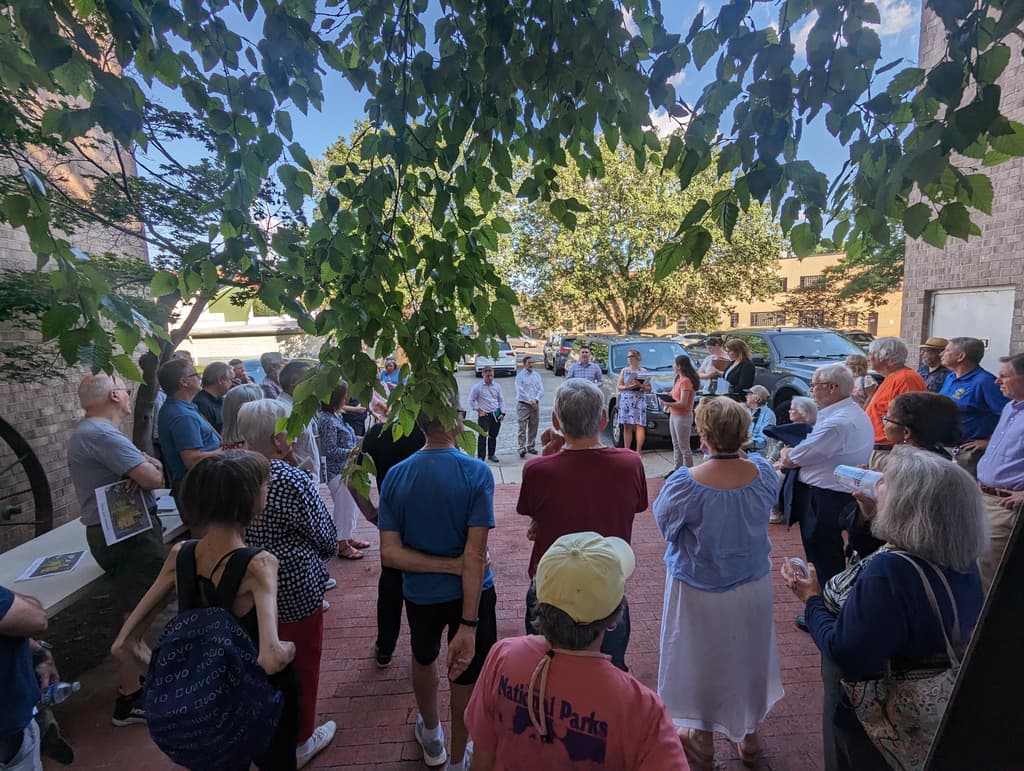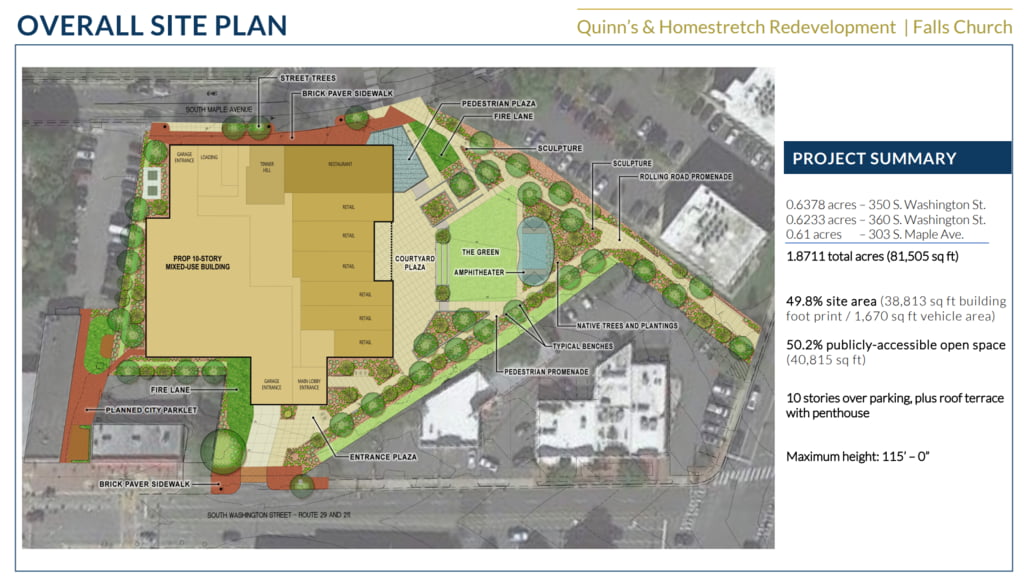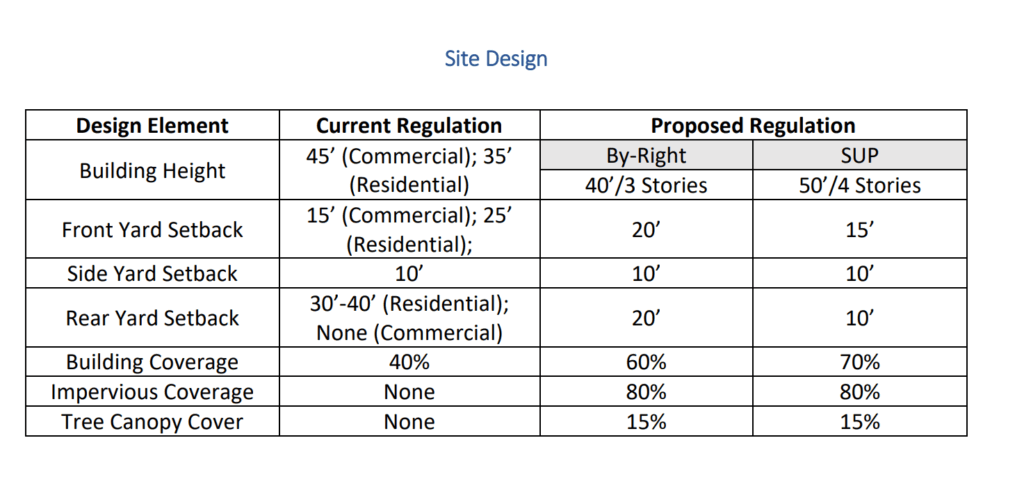Updates from Letty – July 14, 2023
Blog posts are the personal views of Letty Hardi and not official statements or records on behalf of the Falls Church City Council
Dear Friends,
It may be the “dog days of summer”, but city business marches on (figuratively and literally – we had one walking tour this week and another next Monday). In our lengthy work session this week, we discussed a number of meaty, important topics that I hope you’ll take time to understand and offer me input. This post spans economic development, housing, and environment – something for everyone!
- The senior mixed use project proposed at the Quinn/Homestretch site on S. Maple.
- T Zones – as the proposal continues to evolve over the past 2+ years based on market input and community feedback to achieve the policy goals shared by a majority of City Council, I’ll update you on the latest iteration and offer some market context, including my latest geeky reads.
- Several environment topics – including the possibility of upgrading another city building to a geothermal HVAC system and the curbside composting program.
Speaking of environment – if you would like to do more to make your home and lifestyle greener, Falls Church Climate Action Network and Falls Church Forward are hosting an Electrify Falls Church Open House tomorrow (Saturday July 15) from 10-1 near the Farmer’s Market. The event will feature a chance to chat with your neighbors about electric vehicles, rooftop solar, electric appliances and lawn equipment, tax credits, and more. RSVP to receive the address.
Stay cool,
Letty
What Happened This Week:
(1) Quinn/Homestretch Project Walking Tour & Project Submission #2
Since our last discussion on the 55+ full spectrum senior living project back in April (see my blog post on our first look at it), this week we held a walking tour of the site with the community and then a work session discussion on their latest submission. There were a few changes to the project in response to our comments: a small increase to 233 units of senior housing (146 of them would be for independent living and the rest would be for assisted living and memory care), medical office, restaurant, retail, and civic uses across 10 floors/115′ in height; commercial mix of 18% of the project; reworked frontage on S. Maple based on City Council feedback. The project will still have two linear parks, contributing to over 50% of the land as publicly accessible open space and solid fiscals of net annual benefit of $867K or $466K/acre.
Letty’s thoughts: While it’s a large and tall building as proposed, it replaces 40K square feet of old office space with senior living and 52K square feet of new office space for medical office, retail/commercial, and restaurant uses, generates healthy fiscals to continue adding to the city’s tax base, and adds a lot of community benefits in the form of outdoor space for the entire community. As 25% of our population is 55+ and only growing, this project helps meet the need for more senior housing in the city and region. We all shared further feedback this week, from which we heard positive reception by the developer team. My comments in particular: the affordable housing contribution as proposed; setback and orientation of the retail space on S. Maple and the courtyard and the commitments on the build outs to maximize the success of the ground floor; residential vs commercial parking mix, including potential for more free parking spaces for public use and to catalyze future redevelopment of adjacent properties on S. Washington; use of permeable materials on the hardscaped areas to minimize runoff (beyond the stormwater requirements already required); public art contribution.
(2) T Zones
In the 22nd public meeting on Transitional Zones (aka T Zones) this week, we reviewed the latest iteration of the proposed zoning changes to reflect feedback from our June work session.
As a quick refresher or if you’re just tuning into T Zones:
- T Zones effort has been in progress for over 2 years: if you’ve been following this discussion since its inception in 2021 (here’s one of my old blog posts from Jan 2022 after our 3rd work session) – the effort to modernize T Zones (about 3% of the city’s land, primarily limited to Park Ave, N. and S. Washington – see here for a map of the handful of parcels) has always been about encouraging small scale, infill development especially of more diverse housing types and price points that we need in Falls Church. Coupling that housing need with the fact that we haven’t seen any reinvestment in T Zones for decades, T Zones was identified as an opportunity for modernization in 2021.
- The proposed code has evolved and incorporated much input: staff has developed zoning changes and iterated on those based on community input, market input, and urban planning design principles to encourage projects that are economically viable given high underlying land costs. Since our May 2022 first reading 5-2 vote where we referred out the proposal to the Planning Commission, Housing Commission, Environmental Sustainability Council where they provided us their expertise, we have continued to gather more input and the code has evolved.
- The proposed code improves various elements that govern the site design/building envelope from what can already be done by-right today: for example, it’s not discussed enough that a property owner already can build to 45′ in height by right in T zones (by right = with no approval from the city). Outside of numbers, it’s also worth pointing out that environmental protections are actually *increasing* by adding tree canopy and stormwater requirements, which there are none today in the T zones. And if a developer wanted to seek a taller or bigger building, they would need to seek City Council approval via the Special Use Permit (SUP) process. Those parameters, even under a SUP, are defined and not unlimited. We understand that details like this matter to neighborhoods and are important to good design, so have spent months listening and balancing the various points of view. The chart below does a great job summarizing from what can be done today vs proposed (from this document for next Monday’s walking tour):

What’s the latest?
- Price points and sizes matter: the DC area, especially Falls Church, is a desirable place to live (and where you live matters a lot more than where you work in the post-Covid world) which means that housing prices keep surpassing wage growth. And new housing supply in the middle market (what I define as $800K-1M as the average sales price in Falls Church is $1M now) hasn’t been built in decades. All of this means it has become increasingly difficult to make it into the Falls Church, downsize from a single family home, or upgrade from a 1-2 bedroom apartment. As reference (or cautionary tales), here is what is being built in the region: luxury townhomes of 3-5 bedrooms just outside the city ranging from $900K-1.4M and 3 bedroom, 3 car garage “cottages” in Vienna starting at $1.3M. And looking at our own city, the two sets of low density townhouses on Park Ave, built in the past two decades are between 4 bedroom, 2 car garage units around 3-4K square feet and sell for $1.4M. Obviously housing size correlates to housing prices.
- Units/acre and square footage guidance: as 4+ bedroom, $1.4M+ homes already exist and/or are being built in single family neighborhoods, one of our key policy objectives has been to encourage the production of smaller (and therefore more naturally affordable) housing types in the mid market. From conversations with the community and realtors, there is also a lot of pent up demand for housing that is smaller. In the most recent changes we discussed in our June work session and this week’s work session, we discussed staff’s recommendations to steer the market by limiting unit size (2K max average size) and a proposing 14-30 units/acre range to achieve the lower price points we need. If we didn’t propose parameters like these, I fear we’d end up with housing similar to the regional examples above – which would still have demand, but doesn’t accomplish our housing goal.
- Townhouses and more: The most common middle housing form is townhouses if you are anchored in the 1970s-2000s style of housing development.
- The current day housing market is actually way more creative than that! From the Increments of Neighborhood book, there is a multitude of real-life housing examples that have been built in the region that span this middle market that “add density supporting retail and other uses that would not otherwise exist with townhouses or single family homes alone.”
- I also highly recommend this article, albeit a few years old, that also explains why gentle density in stacked townhouses (two-over-twos, two-over-ones, and more) and similar housing forms would help lower the price point. For example, “builders like stacked townhouses because they take up the same amount of space as one townhouse, which saves on land and infrastructure costs. Unlike traditional apartment or condo buildings, these homes don’t have lots of common hallways and lobbies that can be expensive to build and maintain. Stacked townhouses are also great because they provide the same amount of space and privacy as a townhouse at a lower price, which might enable buyers to live closer in than they could otherwise afford.”
I look forward to the walking tour next week where we can look at learnings from previously built projects (often referenced like the Spectrum) that have been incorporated by staff into the current T Zone proposal and continue discussing the site design rules to encourage the market to help us meet the policy objectives of smaller, middle housing – ahead of a first reading vote at our August 7 meeting.
(3) Enviro Topics
Government Operations Energy Action Plan
We previewed the GOEAP (Government Operations Energy Action Plan), which is up for adoption next week. While it’s a mouthful, it’s 1 of 2 important plans we committed to developing and adopting to help the city reach our goals of 50% reduction in greenhouse gases by 2030 and 80% by 2050 – one focused on the community and one on government operations. We allocated funding in the last few budgets to undertake both plans. While the emissions from government facilities only make up 3% of the city’s total emissions, we believe it’s important to lead by example to residents and businesses to live our values while being fiscally responsible. (If you don’t want to read the full plan, the staff presentation slides do a good job summarizing.)
The plan is quite detailed and ambitious and maps out a timeline of strategies and actions. It will take a combination of upgrades in facilities, transition to an electric fleet, onsite solar, and long term power purchase agreements – some of which will need to be carefully balanced in upcoming budgets.
Which is a great segue to…
Community Center HVAC Upgrade
We all had a bit of sticker shock in the report out that the $1M option for the planned HVAC replacement at the Community Center would no longer be possible. Due to inflation and scope issues, the options are now either $3.3M for a more efficient HVAC (but still uses a combo of electricity and natural gas) or a $3.75M for a geothermal system. After discussing the payback period and alternative options – we preliminarily authorized staff’s recommendation to further explore the geothermal option by proceeding with a test well in order to further refine the cost estimate.
Curbside Composting
We are proud of our recycling and composting efforts in Falls Church – through curbside and drop off composting, over 1,003 tons of organic waste have been diverted from our trash. Both composting programs have contributed to our high recycling rate report, putting us at #1 in Northern Virginia and #2 in Virginia in 2022.
Unfortunately as we all know – costs are going up everywhere! Currently, the 570 households that use curbside composting pay $6/mo and the city subsidizes the remainder of the service, which costs $30K in FY23 under the current vendor (the total cost currently is about $70K, combining the city’s share + monthly fee for households). The new contract for the program will cost $141K per year, which was the lowest bid in the competitive bidding process we initiated this spring. Based on survey results and Council discussion on options, we are recommending more cost-sharing with households and the city funding the additional increase.
What can you do? If more households sign up, it could reduce the costs. Help spread the word!
What’s Coming Up:
Monday, July 17 – T Zones Walking Tour (6 pm) & City Council Meeting (730 pm)*
Monday, August 7 – City Council Meeting*
*Mondays (except 5th Mondays and holidays) at 7:30 pm. You can access the agenda and livestream here, including recordings of past meetings